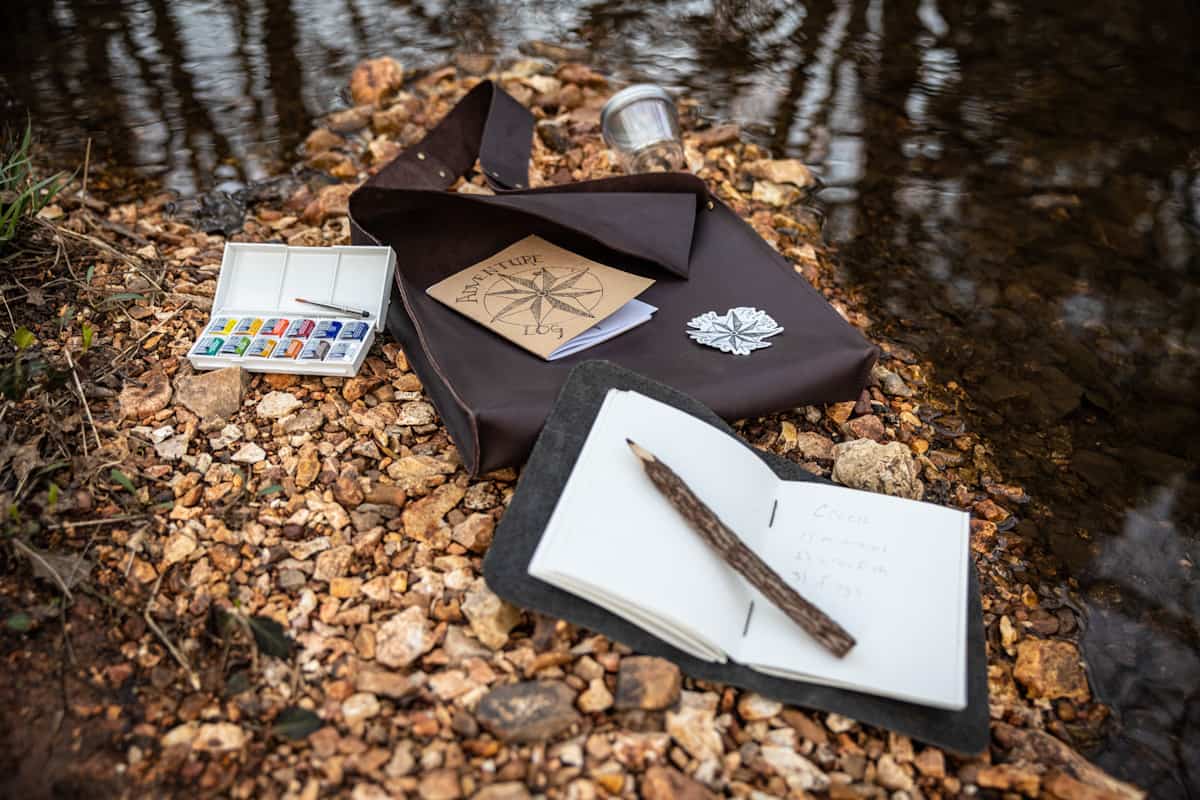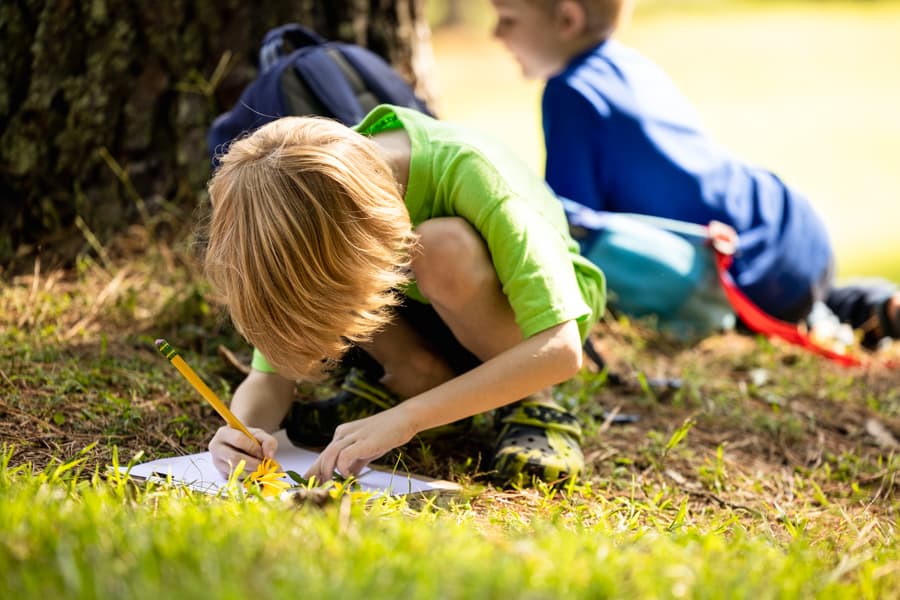Are you looking for a great way to add wonder and exploration to your time in nature? Well, look no further! Nature journaling, perfect for a variety of ages and interest levels, can lead to learning, developing observation skills, and making memories. Plus, the supplies and costs are minimal, so it’s an easily accessible activity. Today, Laura Stroup, Missouri mom of three, is here to let you in on the simple secrets of this valuable pastime. With such diverse possibilities, nature journaling is an enriching and engaging activity that encourages a deep connection with the natural world.
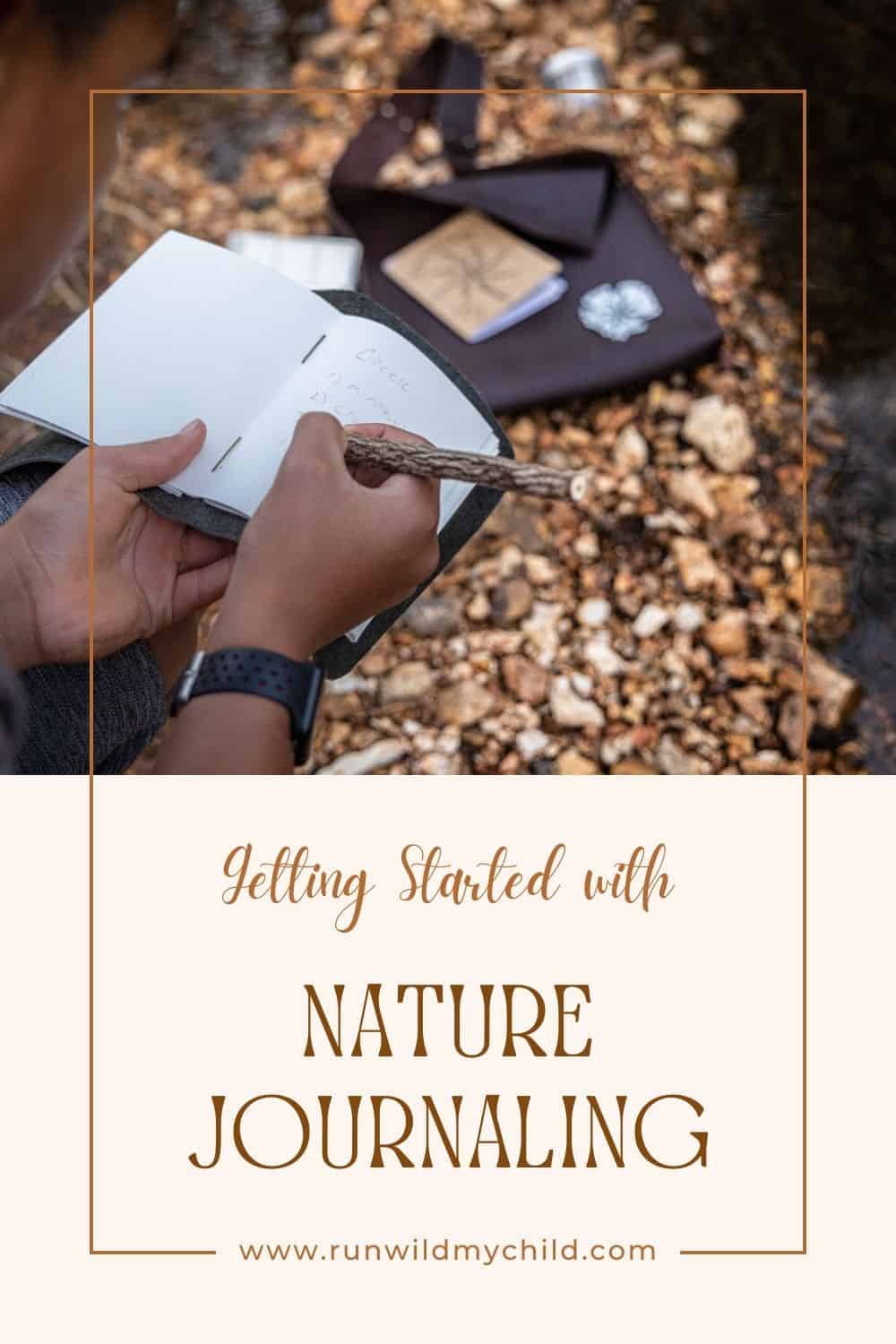
Nature journaling with kids
George Washington Carver once said, “Reading about nature is fine, but if a person walks in the woods and listens carefully, he can learn more than what is in books…” And I am inclined to agree with him. Our family spends time in nature daily. Because nature has so many benefits for us, we want to help inspire your family to do the same.
Something we combine with our nature walks is nature journaling. It is one of our favorite things to do, especially when we have been busy or on the go. Nature journaling quiets us, helps us slow down, and restores peace in our day. Nature journaling’s multidisciplinary approach involves many subjects, so it appeals to a wide audience. And it works with different age groups and ability levels because there is not one way to do it. It’s open-ended and forgiving.
Benefits of nature journaling
Connection to nature
There are so many benefits of nature journaling for kids. Perhaps most importantly, nature journaling inspires us to be outdoors and connects us with the natural world. It encourages curiosity about the world around us. We learn how to ask questions. And we discover how to seek out the answers to those questions through the help of those around us, books, websites, and documentaries. This sense of wonder not only enriches their educational experiences but also lays the foundation for a lifelong appreciation of nature. Nature journaling can be a gateway to science, ecology, and environmental stewardship, instilling a lifelong love for learning and discovery.
Observation skills
Nature journaling also teaches us how to observe with all our senses. We begin to see, hear, and even smell our surroundings like never before. As kids start to journal, they learn to observe the world around them in a whole new way. This heightened awareness not only deepens their connection to the environment but also nurtures essential scientific skills and curiosity. Through the process of sketching and describing what they see, children develop an acute attention to detail, honing their observation skills.
Fosters creativity
Additionally, nature journaling serves as a creative outlet, enhancing self-expression in children. Through drawings, descriptions, and personal reflections in their journals, children can freely express their thoughts, feelings, and experiences in connection with nature. The act of recording our thoughts, ideas, and observations on paper makes them concrete and creates memories of our time in the great outdoors.
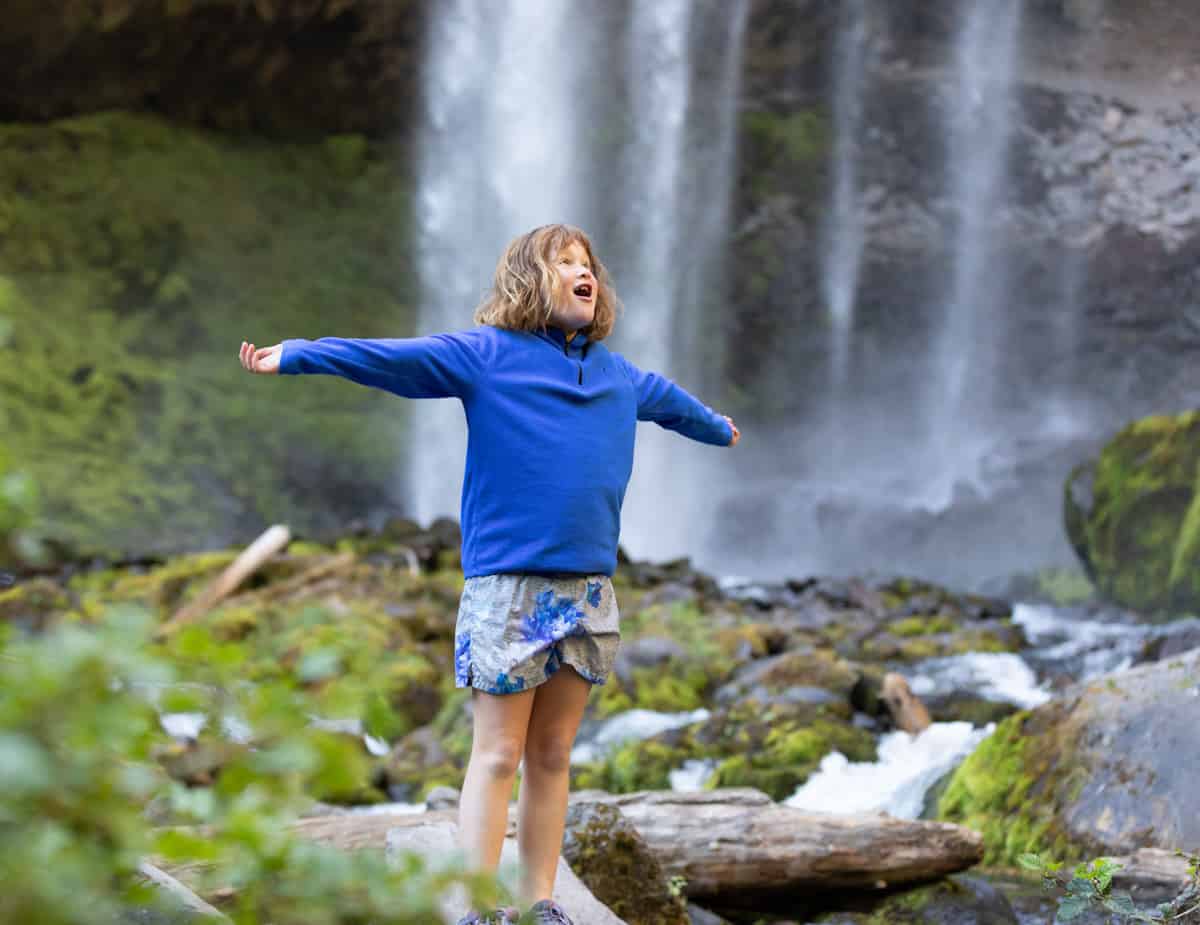
Nature journaling supplies
To get started with nature journaling, you only need a few supplies, many of which you probably already have on hand. Nothing fancy or expensive is required for this activity, and all the supplies should fit comfortably in your backpack if you decide to take them with you.
- Paper – We prefer blank pages rather than lined paper, but a lot of people also like graph paper. You can buy a blank notebook, nature journal, or DIY nature journal with completed pages. Journal pages can be kept in a notebook, loose in a folder, or added to a binder.
- Writing utensils – We prefer to use pencils, but some people like to use colorful pens or markers for writing and drawing.
- Adding color – Colored pencils are our go-to, but watercolors, crayons, markers, and even watercolor pencils work well.
- Camera (optional) – Whether a fancy DSLR, a phone camera, or a simple Polaroid, adding photos to your nature journal from your adventures can enhance the experience.
- Magnifying glass, binoculars, or pocket microscope – These items help kids observe details of any natural object close up and get a better sense of the intricacies of nature.
- Field guides or identification apps – We use these to help us identify what types of flora or fauna we’re observing. iNaturalist is a great app for identifying plants and flowers. We also have a laminated field guide for common birds in our area.
One family journal or individuals?
My kids and I each have our own nature journal. When they were small, I had one for the family that I kept and maintained. However, as they got older, they wanted their own journals to be customized as they saw fit. If you have older children, nature journals and supplies make great gifts and are a fun way to help encourage kids to spend more time outside.
Getting started with nature journaling
There’s no time like the present to start incorporating nature journaling into your outdoor routine. If you don’t currently spend a lot of time outdoors, let nature journaling be the catalyst for changing that! It’s a creative way to combine learning, creativity, and outdoor adventure.
To get started, I recommend that you choose a location that’s easily accessible and abundant in natural elements. This could be a local park, nature reserve, or even your backyard. Encourage children to explore and observe their surroundings, paying attention to the colors, textures, and sounds of nature.
When introducing kids to nature journaling, make it fun and focus more on the exploration and discovery of nature than on their artistic ability. Begin with simple activities like identifying and sketching common plants or animals, and gradually progress to more detailed observations. Encourage them to use their senses – touch, smell, and sound – to deepen their connection with the environment. Making it more about playing outside is an easy way for them to connect journaling with fun.
Make sure to keep a non-judgmental attitude towards their drawings and notes, emphasizing the process of observation over creating perfect representations. By keeping the experience light-hearted and fun, children are more likely to develop a genuine enthusiasm for nature journaling, making it a fun activity and not a chore.
When to use your nature journal
Setting aside dedicated time for nature journaling ensures that the experience becomes a regular and anticipated part of their routine, providing a consistent opportunity for connection with the outdoors. But there’s no one perfect way to journal – it’s up to each person to journal as fits their needs and schedule.
You may choose to bring your journaling supplies with you when you go outdoors (even in your own backyard), but you can nature journal when you get home as a way of taking inventory of all the memories you made, plants and animals you saw, and adventures you braved.
Some people even like to do their nature journaling before heading out to explore, researching the things they might encounter or observe while at a particular location. We have been known to pull out our nature journals on a rainy day and take off on a virtual adventure through a book or documentary.
If you choose to do your nature journaling in the field, it is helpful to find a spot to sit that’s comfortable, safe, and off the beaten path. It’s an excellent way to take a mindfulness break and enjoy the moment. If you have young children in tow, you might also need to pull out some snacks to keep them occupied while you all journal (and make it fun!). Keep your expectations simple, and start small.
What to include in your nature journal
Nature journaling is all about documenting your observations in nature, but there’s no one right way to do this. The sky’s the limit for what to include on the pages of your journal. Because the options are virtually endless, we have a list of some ideas below to avoid the “blank page problem” that sometimes makes it challenging to get started.
Three very general things to include are (1) information, (2) illustrations, and (3) photographs. This can be accomplished in a variety of ways and works for people of differing ages and abilities.
Nature journal prompts and ideas
- Include a short paragraph of information recounting your observations might include the things you see, hear, smell, or feel around you.
- Include common names and scientific names of the plants you find in nature. This is a fun project for older kids to get them familiar with how the scientific naming process works.
- Bullet points are my favorite way to jot down observations quickly. You can always go back and add more detail later.
- Write a poem to describe your entire experience or one animal, plant, fungi, river, sunset, etc that you observed. We especially love acrostic poems, haikus, and shape poems (calligrams).
- Compose a story based on your explorations. Both fiction and non-fiction stories capture moments from your adventures to preserve them as memories.
- Create simple illustrations of your surroundings as a whole or in part, which leads to further research after your outdoor experience. This means learning about different species of living things or landmarks you saw.
- Combine nature journaling with a scavenger hunt, where kids are tasked with finding (and recording) certain items.
Details and tactile experiences
Kids can incorporate details such as the date, time, location, season or time of year, and weather conditions during their outdoor adventures. This not only adds context to their entries but also introduces the concept of tracking changes in nature across different seasons.
Encourage them to collect and attach found objects like leaves, feathers, seed pods, or pressed flowers to their journals, creating a tactile and interactive dimension to their records. It adds so many fun textures and different colors to your nature journal.
You could also do bark and leaf rubbings on the trail directly into your nature journal. We like doing these to help us identify species of trees and plants we didn’t know previously. This is especially great for younger children who want to be involved but may not be able to read or write yet.
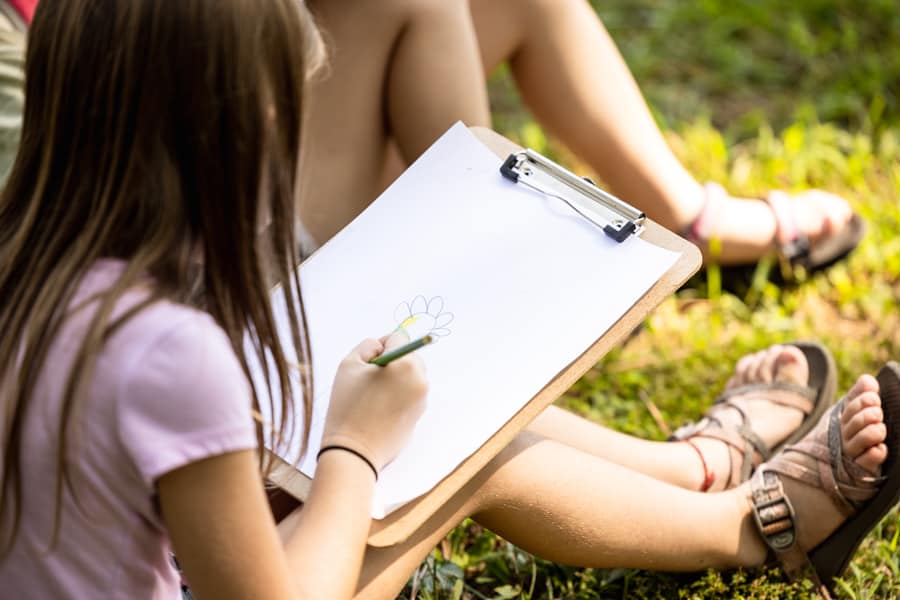
Nature journaling for kids
Nature journaling is a simple yet powerful activity that opens the doors to a world of exploration and creativity for kids. Its open-ended nature allows children to document their unique journey into the natural world over time, filled with their unique observations, thoughts, and reflections. There’s no right or wrong way to journal, making it a fun family activity for recording your nature observations and cultivating a love of nature.
Not only is nature journaling an affordable endeavor, requiring only basic supplies like a sketchbook and pencils, but it also offers the flexibility to be anything a child envisions it to be and can be done at any age! Nature journaling can be done before, during, or after your adventures. It can be as quick and simple or as detailed and intricate as your time and interest level dictates.
For our family, the best things about nature journaling are our time together outdoors and the memories we get to relive and enjoy each time we open up our notebooks and lovingly flip through the pages. So, grab some paper, step outside, and let the adventure of nature journaling unfold.
Additional resources for nature journaling
Nature journaling with kids is a great idea, especially if you’re looking for a wonderful activity that seamlessly combines creativity and outdoor exploration. If you’re interested in learning more about nature journaling or how to get kids started, here are a few of our favorite resources on this topic and recommendations:
- How to Find a Nature Sit Spot
- John Muir Laws (Guide to Nature Drawing & Journaling)
- Nature Notebook
- 100 Nature Journal Prompts for Kids
- How to Press Flowers for Nature Journaling
- Free Scavenger Hunt Bundle for Kids

About the author
Laura is an ecology writer and the founder of Firefly Nature School, a nature study curriculum designed for homeschooling families, co-ops, and classrooms. Laura has a Bachelor of Science degree in Animal Ecology from Iowa State University with an emphasis in natural resource education. A former wildlife conservation educator and upper school science teacher, she now directs School of the Wild, a local nature school serving her community. In her free time, she enjoys traveling with her family, hiking, running, writing, reading, and cooking. Laura lives with her husband and their three children in the beautiful Ozarks countryside.
Find more from Laura in the following locations:
Website: Firefly Nature School
Instagram: @fireflynatureschool
Facebook: Firefly Nature School
RWMC posts: Laura Stroup

